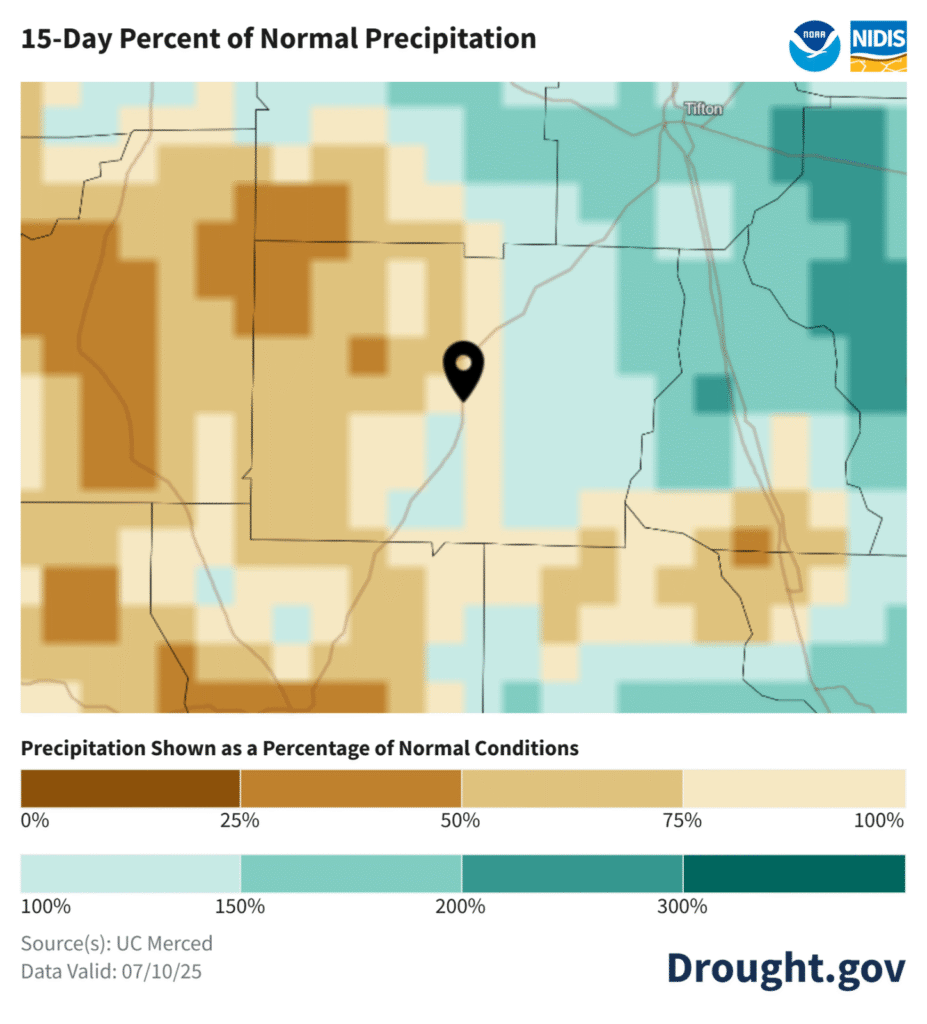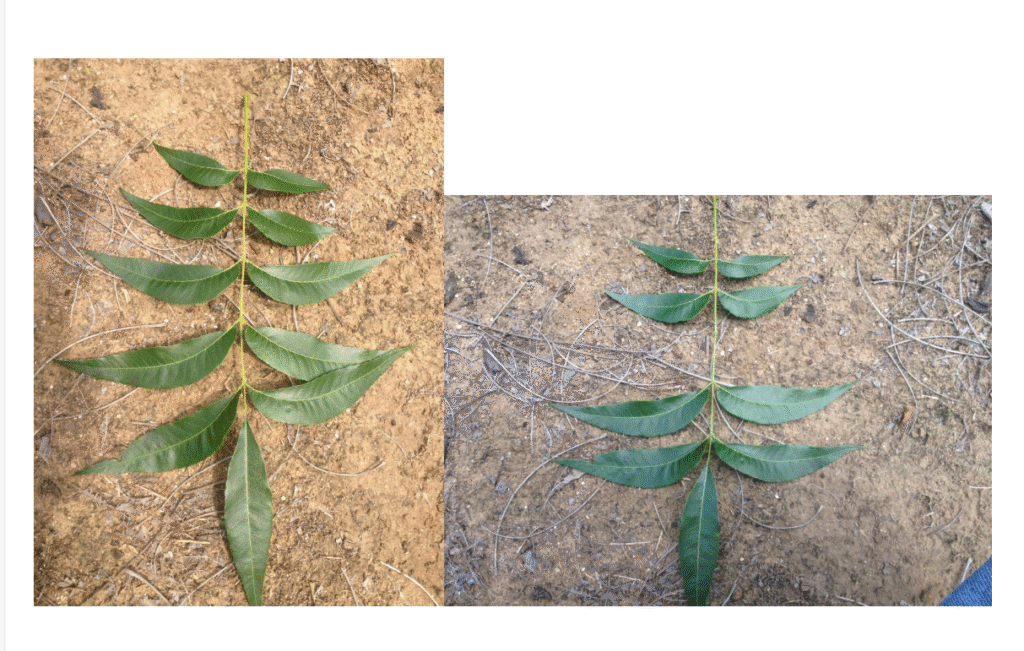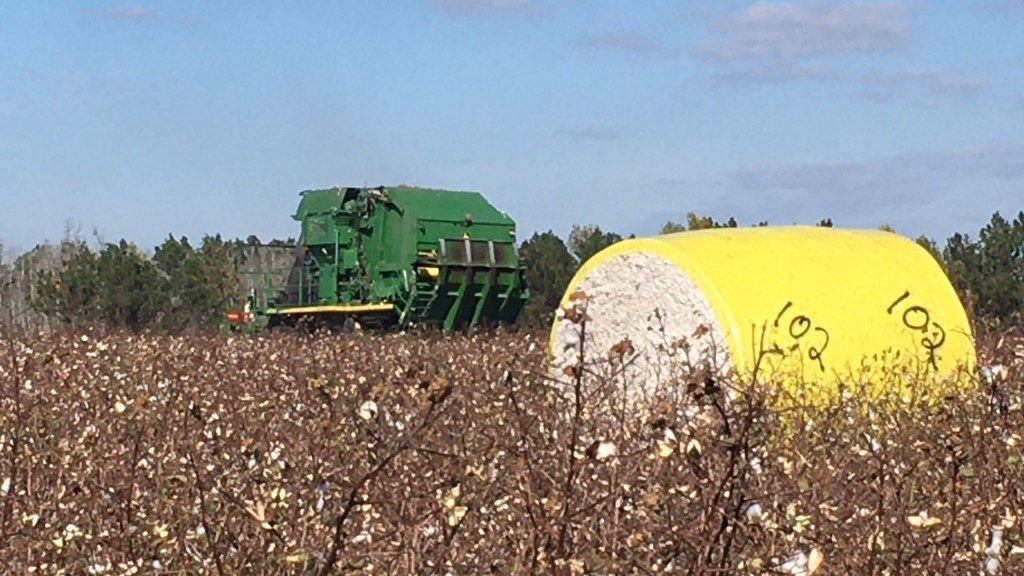In this issue: Cotton and peanut situation, nozzles, pecan nut drop, spittlebugs, and corn irrigation termination.
The Drought Monitor this past week shows that no areas in Colquitt County are affected by drought. Rain chances are increasing toward the middle and end of the week. The illustration below shows the 15-day percent of normal precipitation. This map shows precipitation for the past 15 days as a percentage of the historical average (1991–2020) for the same time period. Green/blue shades indicate above-normal precipitation, while brown shades indicate below-normal precipitation.

Cotton: The aphid fungus Neozygites fresenii has been observed in a lot of fields across Colquitt County. This fungal epizootic typically occurs in early to mid-July depending on location. Once the aphid fungus is detected in a field (gray fuzzy aphid cadavers) we would expect the aphid population to crash within a week.
There has been a conversation or two about plant bugs this past week. Dr. Roberts reminds consultants, scouts and growers that a drop cloth is the best sampling tool for immature plant bugs. The threshold for plant bugs when sampling with a drop cloth is 3 bugs per 6 row feet. Also remember that clouded plant bugs should be counted 1.5 times and added to the tarnished plant bug count. Immature plant bugs can feed on large squares which the plant will not shed. These damaged squares result in “dirty” blooms (discoloration of anthers or misshapen petals). The presence of dirty blooms suggests you have or had immature plant bugs, and you need to make drops in the field to quantify immature plant bugs. During 2024 we saw poor control of plant bugs with bifenthrin which is commonly used for control of stink bugs. The lack of control with bifenthrin contributed to the late season plant bug problems we experienced.
It will be extremely important that we know what bug species are present when making insecticide applications based on internal boll damage. If no plant bugs are present, bifenthrin stays a good choice for control of stink bugs. Remember as the local crop reaches the third week of bloom the IBD (internal boll damage) threshold is 10-15% when using a dynamic threshold which is shown below. A dynamic threshold which varies by the number of stink bug susceptible bolls present is recommended for deciding when insecticide applications should be applied for boll feeding bugs. The boll injury threshold for stink bugs should be adjusted up or down based on the number of susceptible bolls present. Use a 10-15% boll injury threshold during weeks 3-5 of bloom (numerous susceptible bolls present), 20% during weeks 2 and 6, and 30%(+) during weeks 7(+) of bloom (fewer susceptible bolls present).

Whitefly populations have increased in some stick trap locations in Colquitt County. Scouts need to follow this method to check for whiteflies: 1) Count down from the terminal of the plant to the 5th vegetative leaf (starting with any leaf that is the size of a quarter or bigger), 2) Slowly turn the 5th leaf over to view the underside of the leaf, 3) See if there are any immature whiteflies present. If 50% or more of the 5th leaves checked have multiple immatures on them, then treatments should be started.
Peanuts: Foliage feeding caterpillar pressure has been low in the area peanut crop. The crop ranges from 45 to 75 days old. I have heard of a report or two about early leaf spot in older peanuts. As the crop reaches 60-70 days old the irrigation requirements increase.
Bob says “white mold programs” typically begin at about 60 days after planting when the peanut canopy is larger and more at risk for disease spread, growers should consider putting something out at 45 days after planting for management of this disease. I believe a more aggressive white mold program is justified this season because of early-season conditions and the potential for shorter rotations between peanut crops. Growers can initiate a “white mold” program by one of three ways.
1. Mix 7.2 fl oz of tebuconazole with a leaf spot material, for example chlorothalonil.
2. Use products like Priaxor or Lucento that have fair white mold activity in addition to strong leaf spot control.
3. Initiate the 3-spray Elatus (7.3 oz) or Excalia (2.0 fl oz/A) programs, noting that additional fungicide should be added for protection from leaf spot.
For several reasons beyond those mentioned above, June is a critically important month for disease management and, sometimes, for nematode management as well. Based on planting date, most of the peanut crop will be between 30 and 45 days after planting at some point in June. Thoughts for consideration include the points below.
1. Fungicide programs for management of leaf spot diseases (except for the earliest and latest-planted peanuts) are typically initiated during the month of June. Leaf spot programs should begin closer to 30 DAP when A) the field is at higher risk to leaf spot based upon results from Peanut Rx, and/or when B) fungicides to include chlorothalonil, Mazinga, chlorothalonil + Domark, and chlorothalonil + Alto are used as the first fungicide application.
2. Fungicide programs for leaf spot management can safely begin closer to 45 days after planting when A) the field is low-risk to leaf spot diseases as determined with Peanut X, B) fungicides such as Priaxor, Lucento, or Aproach Prima are used in the opening 45-day fungicide application, or C) Velum, Proline, or Propulse is used in-furrow at planting.
3. Growers should avoid, if at all, possible initiating a peanut fungicide program later than 45 days after planting.
4. The “backbone” of most fungicide programs for control of white mold does not begin until approximately 60 days after planting; however growers often start earlier, especially when short rotation increases risk to disease. Effective ways to begin a white mold program within the first 45 days after plantings are to A) apply Proline (5.7 fl oz/A) in a narrow band over the peanuts, B) include tebuconazole or azoxystrobin with your first leaf spot applications, or C) adopt Elatus or Excalia programs that begin as early as 30 days after planting.
5. Applications of Propulse can be made as early as 45 days after planting to fight leaf spot, white mold, and to supplement earlier nematicide applications for control of nematodes.
The “Good”: Timely fungicide applications (before disease is established) are a critically important tactic for controlling disease. Starting your leaf spot program on-time, often in June, sets the stage for a successful disease management program and best yields.
The “Bad”: Getting behind in a fungicide program early in the season may allow disease to become established that is difficult (if not impossible) to manage later in the season. While I know some growers wait until 50-55 days after planting to begin their program, I strongly advise you to not wait later than 45 days after planting and to begin as early as 30 days after planting in a number of situations.
I had this question a couple of times over the last couple of weeks. What nozzle do I get for peanut fungicides? Dr. Porter suggests that fungicide applications require medium droplets for canopy penetration and coverage, especially in dense crops like peanuts and soybeans. Pressures may be higher in some cases to increase canopy penetration, increasing drift potential. Nozzles that could accomplish this include Twin Flat Fan (TJ60, TTJ60), Air Induction Twin Flat Fan (AITTJ) or hollow cone for these targeted applications.
What about insecticides? Often contact-based, medium droplets for effective coverage on foliage and pests. Dr. Porter suggests nozzles such as Flat Fan or Twin Flat Fan for better leaf surface coverage (XR, TT, TTJ60), air induction (AIXR, AITTJ60) or a hollow cone (TX).
Corn: As the corn crop reaches the dent and milk line stage of development the question about when irrigation can be terminated is on everybody’s mind. The official irrigation termination is when the black layer forms.
Corn will enter the dent stage approximately 31-33 days after silking, and roughly a week after you see the kernels denting, a white milk line will form. This line marks the transition from milky liquid to solid starch inside the kernel. The water demand does decline during this stage; however, grain fill is still occurring and must be supported with water. Water will continue to enter the kernels until you see the black layer form.
Below is an excellent article from Dr. Wes Porter about irrigation termination in corn. Finalizing Corn Irrigation and Determining Termination to Prevent Yield Loss and Maximize Profitability
Pecans: I have been getting a question or two about nut drop this year in pecans. According to Dr. Wells, We’re seeing some nut drop out there at the moment across multiple varieties. Pawnee is quite noticeable but this is not unusual. Most of what we are seeing is a natural drop and is known as the “third drop”. It typically begins just before rapid fruit expansion (abt 55 days after pollination) and is considered to result from failure of the endosperm to develop properly (Sparks, 1992). It is accentuated by self-pollination and drought, the latter of which hasn’t been a problem this year. A certain percentage of the fruit will drop. That is the normal physiological process of the tree. Some years they may drop more than others but this typically stays within a moderate range of 30-50% of the nuts in a cluster. Trees with a heavy crop will look like they are losing more fruit but on a percentage basis it tends to fall within the range expected. Just bear in mind that though the nuts are dropping, the sky is not falling. Happens almost every year. Don’t obsess over nuts on the ground when the trees still bear a good crop. Many will say at the moment “My trees are losing all their nuts”, but once the nuts are fully sized they see that in fact, they still have a pretty good crop. Keep looking up. He wrote a great blog post about this subject.
What about taking pecan leaf samples? Leaf sampling is the most important tool pecan growers have for determining their fertility needs. While soil samples are helpful for checking soil pH and determining any potential problems with competitive uptake between nutrients in the soil, leaf samples tell you the fertility status of the actual trees. Using soil and leaf samples together allows growers to match their fertilizer applications with the actual needs of the tree rather than just shooting in the dark. This provides an excellent opportunity to save a lot of money on fertilizer cost. The general recommended period for leaf sampling is July 7-August 7.

- Collect 50- 100 middle-pair of leaflets from the middle leaf of this year’s growth (See figure above). Use terminal shoots exposed to the sun. Avoid twigs from the interior of the tree. Collect leaflets from all sides of the tree. Avoid leaflets damaged by insects and diseases.
- Abnormal trees or trees not representative of the area should be sampled separately. A complete and accurate description of abnormalities should accompany such samples.
- Sample trees of the predominant variety in a given block. If Schley is the main variety, sample Schley; if Stuart is the main variety, then sample Stuart, etc.
- Immediately upon collection, wipe leaves (entire surface, both top and bottom) with a damp cellulose sponge or cheese cloth to remove dust and spray residue. Do not allow the leaves to come into contact with rubber or galvanized containers. Partially air dry and place in the large envelope of the mailing kit.
- If recent soil test data is not available, it would be advisable to collect a soil sample and have it sent to a soil testing laboratory. By sampling the same trees each year, growers can more readily see the results of any changes to their nutritional programs.
I have a couple questions about spittlebugs in pecan. In the UGA Pecan Spray Guide, Spittlebug infestations are easily recognized by the white, frothy masses on terminals or nut clusters. Definite thresholds have not been established and treatment is seldom needed. If you feel like you have to do something for them, imidacloprid is recommended. Below is an example of spittlebug in pecan.

Have a safe week and if you have questions please call the office,
Jeremy M. Kichler
Colquitt County Extension Coordinator
The University of Georgia Cooperative Extension does not endorse or guarantee the performance of any products mentioned in this update.
